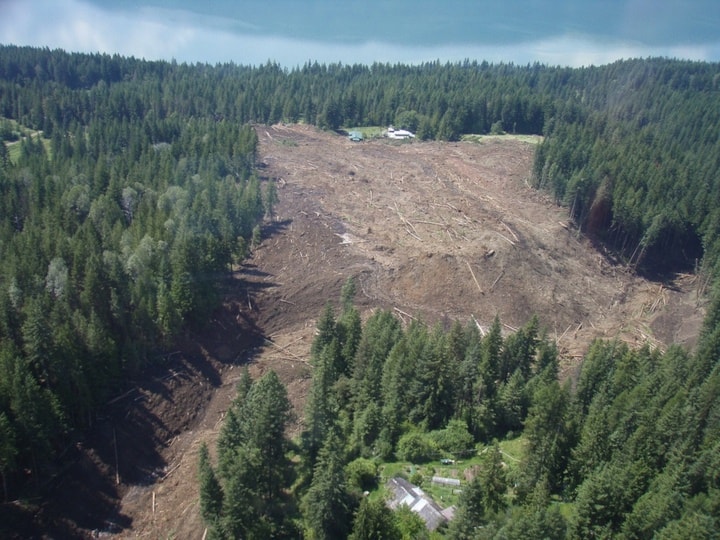Part of the Star’s look back at the top stories of 2012.
On the evening of July 11, Johnsons Landing resident Mandy Bath watched nervously as Gar Creek turned to a thick slurry. She lived near the creek’s mouth, where it emptied into Kootenay Lake, and saw it running a “brown, thick, awful liquid.”
“I was up with a flashlight, worried the bank was going to give,” she recalled. “It was painting the sides of the creek with a mask of mud on every leaf and every rock. I couldn’t sleep.”
It was a warning, she later realized, but when she caught a ride into Kaslo the next day, she never thought her house was in danger.
At about 10:30 a.m., a massive landslide came down Kootenay Joe Ridge, unleashing a two kilometre torrent of mud and debris that destroyed four homes and cut the idyllic community in half.
Caught in the debris were Val Webber, 60, his daughters Rachel, 17, and Diana, 22, and neighbour Petra Frehse, 64.

“People were in shock, and trying to find out which houses were hit and where people were,” said Nelson’s Greg Utzig, who’s had a cabin there for almost 30 years.“It was shocking and distressing.”
The 40 or so permanent residents were used to the challenges that came with isolation. Some evacuated but others stayed, despite no power or water.
Search and rescue and a large RCMP contingent reached the scene by helicopter. The search was called off as night fell, but resumed the next day with the addition of a heavy urban search crew from Vancouver. Still, concerns about stability made for slow going, much to the frustration of Lynn Migdal, mother of the Webber girls.
The 83-acre debris field was constantly shifting, with the swollen Gar Creek still flowing beneath. Combing the five to 10 metre deep debris was described variously as digging in concrete and walking through quicksand.
To reinforce the danger, a second slide came down along the same path. The force snapped trees and frightened boaters cruising along the lakeshore. A Global TV crew caught the whole thing on tape.
When searchers finally reached the Webber home, they discovered it had been pushed 40 meters off its foundation and the roof ripped off. Val Webber’s body was the first recovered, followed by his daughters a few days later.
Webber was remembered as a community volunteer willing to do the dirty jobs others weren’t.
“He was a sweet man,” said niece Sarah Jenkins. “Down to earth, a big kid and loved his family very much.”
Webber belonged to a military family that moved all over Europe before coming to Canada.
Frehse’s body was never found. Her brother Hans-Hubertus Vogt told the Star she spoke to their mother by phone from her cabin minutes before the slide stuck.

Frehse split each year between Johnsons Landing and her native Germany. She and her late husband Jurgen were world travellers, but Vogt said his sister was truly at home in the Kootenays. “She was very well liked in Johnsons Landing,” Vogt said. “She had a lot of friends there. It’s a huge tragedy.”
In the slide’s wake, the Red Cross collected donations for those affected and the Nelson arts community put on a benefit.
The Regional District of Central Kootenay also hired a manager to help the community’s long-term recovery and pooled $80,000 toward replacing the water system that was wiped out.
Despite losing her home, Mandy Bath, considered herself “very lucky” not to have been there at the time. The first slide crushed her house, and the second washed it into the lake.
“It was obliterated and now there is nothing except a muddy slope where the house was,” she said. She and husband Chris Klassen now live in Kaslo.
Decisions on rebuilding the community will hinge on geotechnical assessments expected in the spring.
Geomorphologist Peter Jordan says a large unstable area remains near the slide’s source that could come down, but it’s hard to say when. He blamed the “exceptionally big” slide on groundwater pressures in steep slopes following record rainfall and a high snowpack.
“This is kind of a one in a million,” he said.
